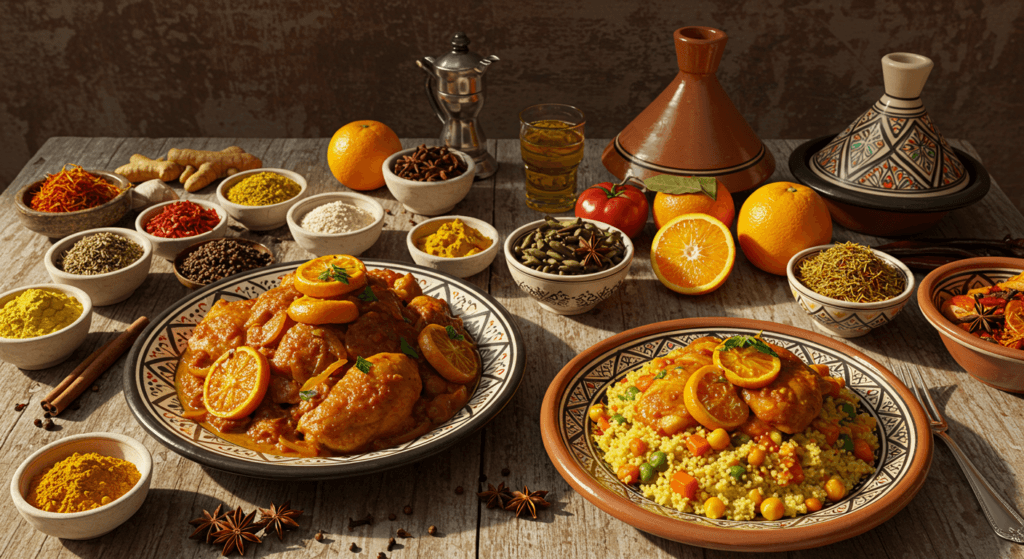
How to Master 5 Classic Moroccan Recipes in One Weekend
Introduction: Can You Really Cook Like a Moroccan Chef in Just Two Days?
Have you ever wondered if it’s possible to whip up authentic Moroccan dishes without spending weeks perfecting them? Well, guess what—you absolutely can! With just one weekend, you can master five classic Moroccan recipes that will transport your taste buds straight to the vibrant streets of Marrakech. Whether you’re a seasoned home cook or someone who burns toast, these recipes are designed to be simple, flavorful, and fun. Ready to dive into the aromatic world of spices and tagines? Let’s get started!
Overview: Why These Moroccan Recipes Are Worth Your Time

What makes these five recipes so special is their balance of bold flavors, ease of preparation, and versatility. From hearty stews to fragrant rice dishes, each recipe showcases the rich culinary traditions of Morocco while fitting perfectly into a busy schedule.
- Time Requirement: Prep and cooking time range from 30 minutes to 1 hour per dish, making them ideal for a productive weekend.
- Difficulty Level: Beginner-friendly! No fancy equipment needed—just a pot, pan, and some basic kitchen tools.
- Health Benefits: Packed with fresh vegetables, lean proteins, and heartwarming spices like turmeric, cumin, and cinnamon, these dishes are as nutritious as they are delicious.
By Sunday evening, you’ll have a repertoire of meals ready to impress family and friends—or simply treat yourself to something extraordinary.
Essential Ingredients: The Heart of Moroccan Recipes
The secret to amazing Moroccan food lies in its ingredients. Here’s what you’ll need for all five recipes:
- Spices:
- Cumin, coriander, paprika, turmeric, saffron, ginger, and cinnamon form the backbone of Moroccan flavor profiles. Don’t worry if you don’t have saffron—it’s pricy, but turmeric works as a substitute!
- Proteins:
- Chicken, lamb, chickpeas, and lentils are staples in Moroccan cuisine. For vegetarian options, swap meat for tofu or extra veggies.
- Fruits & Veggies:
- Onions, garlic, tomatoes, carrots, apricots, raisins, and olives add sweetness, tanginess, and texture.
- Grains:
- Couscous and rice are essential bases for many dishes. Quinoa can also work as a gluten-free alternative.
- Olive Oil and Butter:
- Rich olive oil and clarified butter (or ghee) enhance the depth of flavors.
- Fresh Herbs:
- Parsley, cilantro, and mint bring brightness to every bite.
Substitutions and Variations: Not everyone has access to specialty items. Feel free to use dried herbs instead of fresh ones, canned chickpeas instead of soaking dried ones, or even jarred tomato paste when fresh tomatoes aren’t available.

Step-by-Step Instructions: Cooking Made Easy
Let’s break down how to prepare each recipe step by step. We’ve chosen five iconic dishes to represent the diversity of Moroccan cooking:
- Chicken Tagine with Apricots and Almonds
- Sauté onions and garlic until golden.
- Add chicken pieces, spices, and broth; simmer for 30 minutes.
- Stir in dried apricots and finish with toasted almonds before serving.
- Couscous with Seven Vegetables
- Steam couscous according to package instructions.
- In a separate pot, sauté carrots, zucchini, turnips, and tomatoes with spices.
- Combine cooked couscous with veggies and garnish with parsley.
- Lamb Kefta (Spiced Meatballs)
- Mix ground lamb with parsley, garlic, cumin, and paprika. Shape into small balls.
- Grill or bake until cooked through. Serve with yogurt sauce or flatbread.
- Harira Soup (Hearty Lentil Stew)
- Simmer lentils, tomatoes, onions, and spices in vegetable broth.
- Finish with lemon juice and fresh cilantro for brightness.
- Moroccan Mint Tea
- Boil water with green tea leaves and sugar.
- Pour over fresh mint leaves and serve hot or chilled.
Tips for Success:
- Toast whole spices briefly to release their aroma before grinding.
- Use a heavy-bottomed pot for tagines to prevent burning.
- Taste as you go! Adjust seasoning gradually to find the perfect balance.

Assembly: Bringing It All Together
Presentation matters almost as much as taste in Moroccan culture. Here’s how to assemble and plate your creations:
- Tagine: Arrange the chicken and apricots neatly on a bed of fluffy couscous. Sprinkle toasted almonds on top for crunch.
- Couscous: Mold the couscous into a mound using a bowl, then surround it with colorful veggies.
- Kefta: Stack the meatballs artistically and drizzle with yogurt sauce for contrast.
- Harira: Ladle into bowls and garnish with chopped cilantro and a wedge of lemon.
- Mint Tea: Serve in traditional glasses or mugs, adding sprigs of mint for flair.
Pro Tip: Garnishes like pomegranate seeds, sesame seeds, or fried onions can elevate any dish instantly.
Storage and Make-Ahead Tips
One of the best things about Moroccan recipes is that they often taste better the next day! Here’s how to store leftovers safely:
- Refrigeration: Store soups, stews, and tagines in airtight containers for up to 3 days. Reheat gently on the stove.
- Freezing: Most dishes freeze well for up to 3 months. Label containers clearly!
- Make-Ahead Components: Prepare spice blends, chop veggies, or marinate proteins ahead of time to save effort during cooking.
Recipe Variations: Get Creative!
Once you’ve mastered the basics, feel free to experiment:
- Swap chicken for beef or tofu in the tagine.
- Add pumpkin or sweet potatoes to the couscous mix.
- Use harissa paste for a spicy twist in kefta.
- Infuse mint tea with rosewater for a floral touch.
There’s no wrong way to enjoy Moroccan recipes—customize them to suit your preferences!
Conclusion: Embrace the Magic of Moroccan Cuisine
Congratulations! By now, you’ve learned how to master five classic Moroccan recipes in just one weekend. From comforting tagines to refreshing mint tea, these dishes prove that exotic flavors don’t have to be complicated. So why not invite friends over for a Moroccan feast or surprise your family with a new favorite meal? Remember, cooking is all about having fun and exploring new tastes. Now, grab those spices and start creating your own Moroccan masterpiece!
FAQs About Moroccan Recipes
Q: Are these recipes healthy?
A: Absolutely! They’re packed with nutrient-rich ingredients like lean proteins, whole grains, and fresh produce. Plus, the spices offer anti-inflammatory benefits.
Q: Do I need special equipment?
A: Nope! A regular pot or skillet works fine for most recipes. If you want to invest later, a clay tagine pot adds authenticity.
Q: Can I make these dishes vegan?
A: Yes! Substitute meats with plant-based proteins like chickpeas or lentils, and use olive oil instead of butter.
Q: How long do leftovers last?
A: Most dishes keep for 3 days in the fridge or several months in the freezer.
Q: What’s the key to balancing flavors?
A: Balance sweetness (from fruits), acidity (from lemons or vinegar), and warmth (from spices). Taste frequently and adjust as needed.
Now that you know everything there is to know, it’s time to roll up your sleeves and embark on this flavorful journey. Happy cooking!


